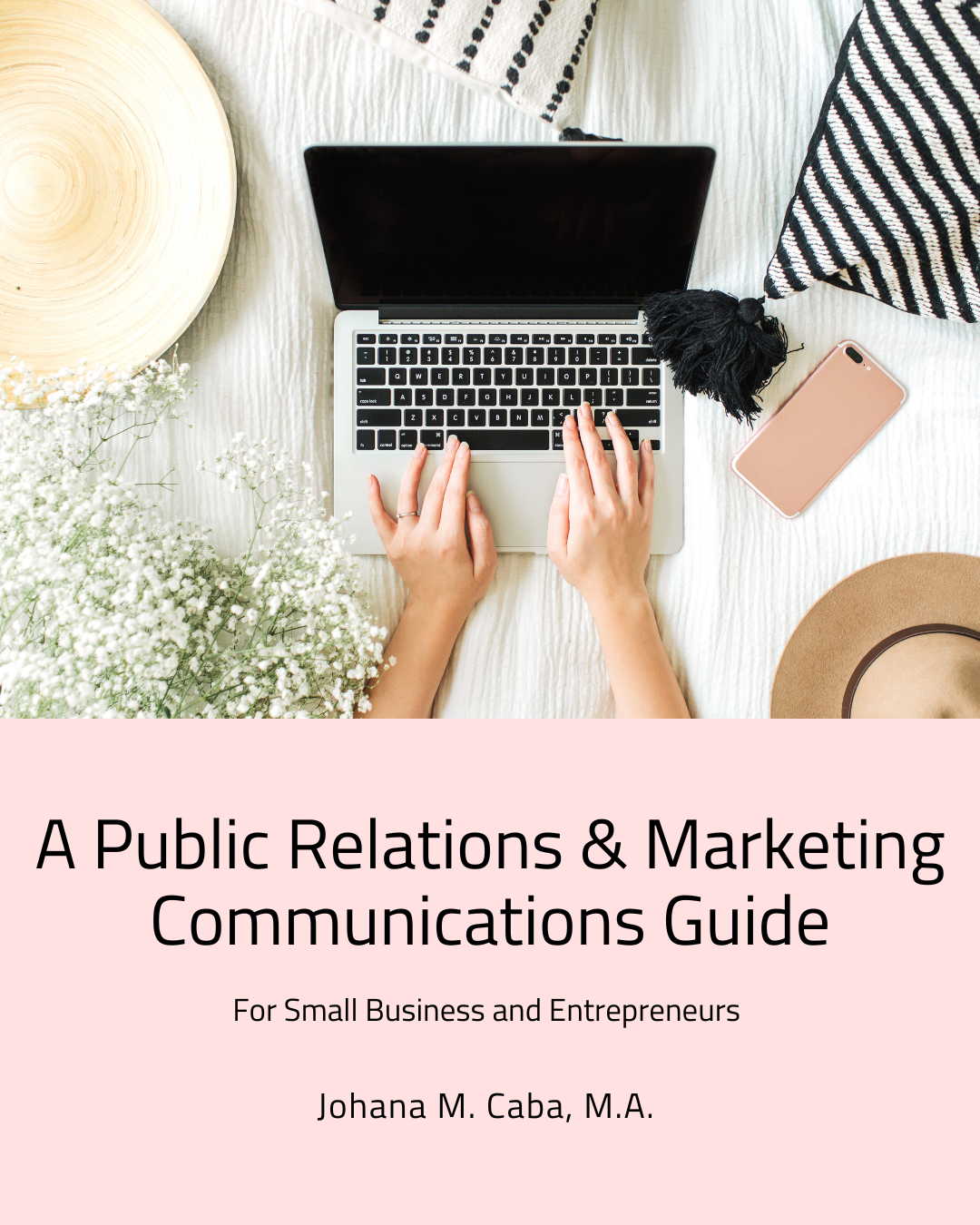|
Johana M. Caba, M.A.
Crafting a new brand identity can be an exciting and fear-provoking initiative. A brand identity is defined as the way in which an organization presents itself to the public through visual elements (typography, color palettes, icons, images, etc.) that come together to create a distinctive image in the minds of consumers and clients. Branding is an important component of any organization. But, how do you know when it is time for a rebrand? A rebrand is not only about updating visual components of an organization, but it is also about maintaining the voice and personality of the original identity. It can be a tricky process, but it can also be an exciting new avenue of creative expression. Below, you will find a rebrand case study of a tech startup. Towards the end of 2022, I began working on a rebrand of a fairly new organization. The tech startup had been around for a few years, and through their change of leadership they were motivated to update their brand identity. The goal was to take the existing brand and modernize the visual components as well as re-launch their entire website. The original branding consisted of two different logos, no distinct color palette, mismatched typographies, and no consideration for the user experience on their website. The look and feel of everything was that of a share drive where information was offloaded without branding consideration. Honestly speaking, it took time to figure out how to position everything and work towards creating a new, modern, and sleek feel with a pop of vibrant color. Working with a team of web developers and designers, we created a strategy that completely transformed the brand of the organization while staying true to its core identity. A Step-by-Step Discussion of the Results Although everything was worked on simultaneously, the logo was the first piece of the puzzle. The organization had two different logos that they were using interchangeably. As organizations grow and develop, they can have different logos, but the logos need to connect seamlessly with one another in the eyes of consumers and clients. The problem here was that the two logos were completely different and were used interchangeably throughout the business. To create a more modern logo that paid homage to the original two, we merged the two logos together and flipped their designated icon to create a more modern illusion. After the logo, we focused on the color palette. Originally, the brand would stick to black and white, with shades of dark blue here and there. We decided to bring a pop of vibrant color while staying true to the original dark blue. Our palette focused on a deeper hue of blue with hints of purple as the primary color along with a medium purple, dark green, and light green as accent colors for depth and vibrance.
For the typography, we stayed true to the original typography but added a few different fonts to create a more modern feel. The font families we paired were Sans Serif and Serif. The fonts we chose were PT Serif, Roboto, and Open Sans.
To bring everything together, we had to create a new user experience for the website. This is where we created a new content hierarchy to strategically arrange information with the most important information emphasized with designated headers up top while other information was displayed less prominently towards the bottom. We also arranged the navigation menu in a way that made sense for users as well as strategically linked important content throughout different webpages for ease of use. Refreshing the Core: Moving Past the Visual Although the visual elements of a brand are important for customers and clients to distinguish one brand from another, it also becomes important to re-evaluate the core of the brand. The core of the brand consists of the mission, positioning, tagline, core values, brand personality/voice, and value proposition. To deliver a consistent brand across all the various customer/client touch points, it is important to clearly understand the purpose of the organization, what they are offering, how their offering benefits their target audience, and how an interested person can get the offering. Assuming a startup or a new company already has their mission, personality, value proposition and so forth, refreshing this content will focus on simplifying it. The more complicated or complex an organization’s mission is, the harder it is for the common person to understand. Some organizations have very complex missions because they offer their products or services to a specific niche. But, simplifying a complex idea will make the organization’s purpose easier to understand and the mission much more memorable and effective. To refresh the core of a business, you need to first understand how everything works. You will need to take a deep dive into the organization, but the outcome will be positive. For example, the tech startup that I worked on had a very complex mission because they were offering their services and products to a very specific niche. Furthermore, that niche consisted of very intellectual individuals that could understand the mission and vision of the startup. That’s perfectly fine when a startup is just launching and it wants to target that specific group. But, as the startup grows and expands their offerings, it becomes more important to simplify those complex ideas. This is important not only for the external audience of the organization, but also for the internal audience of employees that might find it difficult to explain what they do to other colleagues. We decided to first understand the company, diving all the way back to the purpose of its founding. We simplified the mission and made it more specific so that everyone that crossed the various touch points could understand their purpose and what they offer. To take things a step further, we also simplified the mission statement to one sentence that could be displayed on all social media channels. While their longer mission statement lives on their website and print materials, the shorter mission statement can be used on social media. The one-sentence mission is also beneficial for their employees to simplify the complexity of the business when they are speaking about it to others. After the mission statement, value proposition, core values, and brand personality are established, the copywriting will be much easier for those creating the marketing content. It might take a few rounds of editing and speaking to all stakeholders, but it is all a part of the process. After everything is set and approved, the final step is to create a brand style guide that the company can use moving forward to ensure their branding remains consistent. A brand style guide will be very useful as the organization continues to grow and expand their marketing departments or when hiring consultants to help with their marketing.
0 Comments
By: Johana M. Caba, M.A.
As a small business, you might think that you already have a brand. And, although that might be true, you cannot base your branding on having a logo, some marketing, some advertising, and customers. Branding and a business’ brand identity are much more than that. Whereas branding is about having a product or service that is distinguishable from other products and services in that category or industry, brand identity consists of the visible elements of the brand like colors, logo, fonts, images, etc. It is the process of creating content and disseminating that content with the brand name, its qualities, personality, identifiable elements, and distinctiveness. According to MarTech, a brand strategy is “built on a platform of differentiation, where a company can use its value proposition to create competitive advantages and satisfy customer needs”. Good branding can increase sales, it increases the value of a company, it can provide employees with direction and motivation, and it can make it easier to attract new customers. We all know that strong branding improves recognition. Think of your favorite brand. For example, we all know Coke from the distinctive red cans and glass bottles, cursive logo, and taste. That’s because Coke is considered a central brand in the soft drinks industry. Central brands are top-of-mind for consumers and they tend to serve as reference points for comparison. According to a Harvard Business Review article on branding, “striking the right balance between centrality and distinctiveness is critical, because a company’s choices influence not just how the brand will be perceived, but how much of it will be sold and at what price - and, ultimately, how profitable it will be.” Branding is important for many reasons, and as a small business owner, you should consider taking a step back and determining if you have a brand strategy. Like I said before, a logo and some marketing are not the same thing as a brand strategy. The most important goal of your strategy is brand awareness. We want a solid, established, clear, and consistent brand across platforms and channels because we want to raise brand awareness within our target audience. On average, it only takes 7 seconds for individuals to form an impression of a brand, and it takes 5-7 impressions to begin recognizing the company logo. And like with everything else in life, first impressions matter. They are vital to developing a loyal customer base. How is brand loyalty formed? One way is by having shared values with your target audience because this helps to increase relatability and foster stronger relationships. How does a brand become more memorable in the minds of consumers? Think of color. Colors help improve the recognition of a brand in consumers’ minds by 80% because color is one of the first things our brains perceive.
So, how can your small business develop a brand strategy to increase recognition and raise awareness about your business?
If we think from a marketing perspective first, think of these questions:
You can continue the process by thinking about the following questions:
These questions will help you get your thoughts down before you begin crafting your strategy. What is a brand strategy? Now, let’s take a step back for a moment. Let’s think about your product or service. In the world we live in today, competition is in every single niche. So, if your product or service does not resonate with your target audience, then you will not succeed. This is why you need to make sure that your product or service is the right fit for your market, it is solving the problem of your target audience, and your value proposition resonates with them. Value proposition is intended to make your product or service attractive to your target audience. That’s why I keep stating that your brand strategy is not just your logo, some advertising, and some marketing. Why? Because good branding is not just visual, it also helps your business raise awareness and attract customers so that you can hit your organizational and revenue goals. A brand strategy can be defined as a long-term plan that documents specific ideas and concepts to help keep your branding consistent, memorable, and distinct throughout your marketing communications platforms. This plan will cover your purpose, vision, mission, beliefs, core values, attitudes, target audience, value proposition, and positioning. And, it will guide your marketing communications decisions to ensure that you remain consistent, memorable, and distinct.
How to create a brand strategy?
First thing is first, you need to research and understand your customer. You can do this by analyzing the data that you might already have on your website analytics or your social media insights. You can also do this by researching your competitors. Your brand strategy will depend on your ideal customer, so it is always a good idea to define your ideal customer and create personas to guide you. I have an entire section on ideal customer personas and the customer journey on my free guide. Let’s go over how to create your brand strategy:
But, how do you implement the strategy?
Conclusion The key takeaways for your small business are that you need a brand strategy to guide your marketing communications, you need to understand what your brand stands for and what story you are telling, and you need to define your branding and brand identity to remain clear, consistent, and memorable. An important point about your brand strategy is that it will serve as a guide for you, that way your marketing communications work without waste. Meaning, that you are not spending money without a clear objective, purpose, or story. In order to be the most efficient, and get the most for your money, you need to make sure that your message remains clear and consistent throughout all of your platforms.
By: Johana M. Caba, M.A.
What is integrated marketing communications? According to Philip Kitchen and Inga Burgmann's Integrated Marketing Communications: Making it Work at a Strategic Level (2015), Integrated Marketing Communications (IMC) is an expansion of utilizing both modern and traditional marketing strategies, to optimize the communication of a consistent message conveying the company's brand to stakeholders. Like with many things in life, consistency is the key. To optimize message consistency, we must be highly collaborative and bring together people and functions who normally might not communicate with one another. In other words, Integrated Marketing Communications, as defined by The American Association of Advertising Agencies is a marketing strategy that recognizes the value of a comprehensive plan that evaluates the strategic roles of a variety of communication disciplines, advertising, public relations, personal selling, and sales promotion, and combines them to provide clarity, consistency, and maximum communication impact. In order to build collaboration to deliver a single, cohesive message throughout the organization, IMC requires the integration of various functions including:
Why is IMC becoming increasingly popular? IMC is becoming increasingly popular because it is communication that works without waste. What do I mean by this? Integrating marketing and communications is a unique practice because it looks at the promotional mix as a whole instead of separate parts. The promotional mix is a marketing term that stands for product, place, price, and promotion. The advantages of the IMC strategy is that it makes your campaigns more intuitive. Integrating allows for a consistent message across all of your communication and marketing channels. How can IMC help your small business, start-up, or nonprofit? Research-driven initiatives that are focused on delivering results against measurable objectives during specific time frames are most effective. This is why IMC will help your small business, start-up, or nonprofit succeed. Research, SMART goals and objectives, clear and consistent messaging, and building long term relationships with your target audience are essential for the success of any organization. Integrating your marketing and communications is a strategic approach to delivering your message consistently and clearly to your target audience. As communicators, marketers, and business owners, we need to be highly collaborative and bring together people and functions that historically don’t communicate, from marketing to advertising, PR, social/digital media, graphic design, website design/development, event production, and sales. These various groups, departments, or individuals must build collaboration to deliver a single, cohesive message throughout the entire organization. The History of IMC Let’s dive a little deeper into IMC. According to Avocet Communications: IMC is “A term coined in 1989, Integrated Marketing Communications (IMC) began as a need to focus advertising efforts across several different promotional methods. By integrating communications across multiple marketing platforms, businesses discovered that each individual brand message was actually reinforcing the others. The need arose as a result of businesses realizing there were other more efficient and cost-effective ways to reach customers. Focusing advertising efforts in more ways became necessary for the growth of the business, but some quickly realized that consistency and integration between those efforts was just as important.” Many big name brands and organizations have developed IMC campaigns throughout the years. Think about your favorite brand and how they share a consistent message on their websites, on social media, on their ads, through their marketing like email marketing, on TV ads, and even through influencer marketing. There are many successful IMC campaigns that you can start to recognize once you learn more. And, of course, you can do this too, it just takes planning, research, execution, and evaluation. Case Studies: Successful IMC Campaigns An example of a successful IMC campaign is the Old Spice: Smell Like a Man campaign. This campaign integrated great videos, social media, ads, and everything in between with great copywriting that held your attention and sold you the product. This campaign was research-driven in that it was developed based on one key insight, that 60% of body wash purchases are made by women. So, they developed a campaign in which women were the target market by having a shirtless, good looking man, riding a horse on a beach at sunset. Although it is a product for men, the campaign targeted women as research showed that over 60% of body wash purchases were made by women. The imagery, content, videos and everything focused on the key message of smelling like a man and what that looked like through the screen. The imagery helps us associate a scent with the brand even if we don’t know what that scent is, through the power of the mind we can picture what that smell is based on what the ads are portraying. Another example is the Always: #LikeAGirl campaign which promoted a cause rather than a product. This campaign wasn’t designed to sell you a product, which is evident through the consistent messaging across platforms with videos that worked and a hashtag to tie everything together. The videos didn't focus on “selling a product." Instead, through the #LikeAGirl hashtag, the campaign sparked a debate centering around gender equality on social media. The consistent message that was clear and evident throughout the various platforms from images, to digital, to videos and commercials even during the Super Bowl was that girls are strong, smart, and powerful. We as women, know that we are capable of anything and everything and we will succeed, and this message came out through this campaign. A third example is the Levi Strauss: Ready to Work campaign which focused on documentaries about rebuilding efforts in a rundown steel town across multiple media sources which made the campaign an integrated marketing gem. It was real and raw which struck a chord within consumers but most importantly it delivered a clear and consistent message across platforms from video ads, to social media, digital ads, and more. Conclusion These case studies are great examples that clearly show you how IMC campaigns can be highly successful and intuitive. They demonstrate exactly why IMC is the new gold standard of marketing communications. Like I mentioned earlier, the key to IMC is consistency because consistency will help you optimize the message you are trying to convey. Learn More about IMC I created an online course focusing on IMC for small business, start-ups, nonprofits, creators, and any individual or organization that wants to learn more about marketing communications. In my IMC online course, you can learn the process of planning your own IMC strategy for your business and products. The learning objectives of my course are:
Let's work together to learn and create a plan for your brand or organization. Click here to register for the course. |
Categories
All
Disclaimer: We are a participant in the Amazon Services LLC Associates Program, Adobe Affiliate Program, and in the Canva Affiliate Program, these are affiliate advertising programs designed to provide a means for us to earn fees by linking to Amazon.com, Canva.com and affiliated sites. Privacy Policy |
Proudly powered by Weebly





 RSS Feed
RSS Feed
